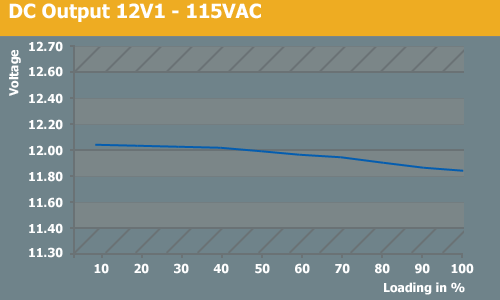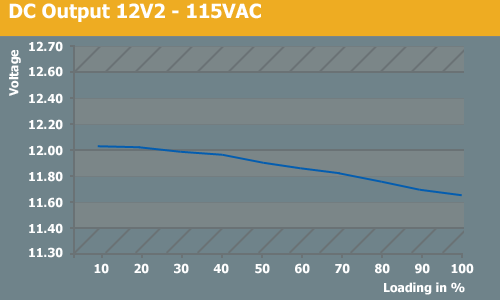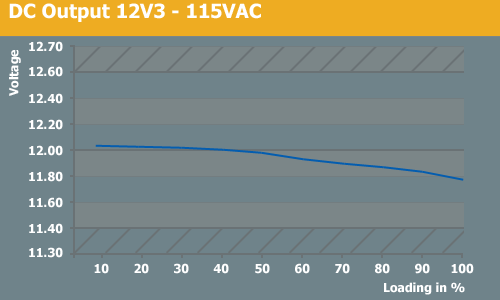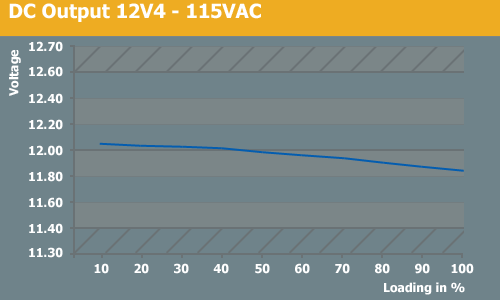The Single 12V Rail SilverStone Olympia OP650
by Christoph Katzer on July 13, 2007 12:00 PM EST- Posted in
- Cases/Cooling/PSUs
115VAC 12V Rail Tests
The 12v rails all performed very well during the test and none ran out of spec. We tested the power supply with the little OCP knob off as we mentioned before (the default configuration). That means that we should have been working with only one 12v rail. As we connected the cables to our machines we discovered that there are in fact four 12v rails at all times. It doesn't matter if you switch this knob off or on, the result will be the same. This could have just switched off OCP on each rail, meaning that they would be separated in some other way. The rails are separated to supply the following:




The 12v rails all performed very well during the test and none ran out of spec. We tested the power supply with the little OCP knob off as we mentioned before (the default configuration). That means that we should have been working with only one 12v rail. As we connected the cables to our machines we discovered that there are in fact four 12v rails at all times. It doesn't matter if you switch this knob off or on, the result will be the same. This could have just switched off OCP on each rail, meaning that they would be separated in some other way. The rails are separated to supply the following:
- 12V1 is supplying the Motherboard (yellow/blue cable)
- 12V2 is connected to the 4pin connector for the CPU (yellow/black cable)
- 12V3 is supplying the second 4pin connector which results in the 8pin connector (yellow cable)
- 12V4 is responsible for all the rest including the PCI-Express cards and components (yellow/green cable)














46 Comments
View All Comments
Araemo - Friday, July 13, 2007 - link
That makes sense, and makes me think my guess about the 20A limit is possibly a contributing factor - It would be a safety issue if someone hung 40A worth of fans, lights, motorized case windows, whatever you want.. off of one pair of wires (IE, one molex connector feeding into the mass of extenders and passthrough connectors that most fans and lights I've seen use.).You'd likely overheat the wires carrying all that power, if not the connectors as well, which could cause fire or electrocution hazards.
While a GPU may draw significantly more than 20A, they are also using 3 pairs now, so the actual power draw will be closer to 20A per pair.
DerekWilson - Friday, July 13, 2007 - link
The PCIe V2.0 PSUs I've seen suggest only using connectors from the same 12V rail for PCIe graphics cards -- because if you don't, you'll be connecting the common from two different 12V rails together.This can cause issues.
If a graphics card has one 4pin and 1 8pin connector, like the HD 2900 XT, the GPU can potentially draw up to 225W from a single 12V rail through 2x PCIe graphics power connectors (3 pairs). That's about 19 amps through one rail for one PSU, but not over each pair.
SilthDraeth - Friday, July 13, 2007 - link
They explained it.The Intel ATX standard calls for no more than 20 Amps per 12V rail. So in order to avoid maxing out a single 12V rail at 20 Amps, PSUs have multiple rails support up to 20 Amps each.
If you use a single rail that can max out at 54 Amps as stated here, then you do not need the additional rails, but you are going against the ATX standard.
Duraz0rz - Friday, July 13, 2007 - link
Also, I didn't see if there was a reason that it was advertised as a single rail, yet you have 4 12V rails.Nice article...really love the line curves for the load outputs. One thing I noticed missing is ripple testing. Any reason why it's not here?
SilthDraeth - Friday, July 13, 2007 - link
That confused me as well. I think they mentioned that the PSU supposedly includes an ability to turn the other rails off, but it doesn't work, and it always has 4. They did state the PCB was originally designed for 4 rails.Duraz0rz - Friday, July 13, 2007 - link
Nevermind...disregard my statement about the ripple testing. I probably just missed it in the original article after skimming the comments from it :)